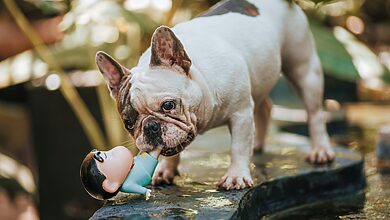Green Living, Happy Pets: Sustainable Choices for Your Furry Friend

In a world increasingly attuned to environmental concerns, it’s essential to extend our green practices beyond personal habits and into every facet of our lives. Our pets, integral members of our families, also deserve sustainable care. Green living and happy pets go hand in paw, creating a harmonious balance between environmental responsibility and pet well-being. This guide explores practical, eco-friendly choices that will benefit your furry friends and the planet. Discover how sustainable practices in pet care can lead to a healthier, happier life for both your pets and the environment.
Table of contents
- Why Sustainable Choices Matter
- Eco-Friendly Pet Food Options
- Sustainable Pet Toys and Accessories
- Green Grooming Practices
- Eco-Conscious Pet Care Products
- Creating a Green Pet-Friendly Home
- How to Recycle Pet Waste Responsibly
- Tips for Reducing Your Pet’s Carbon Pawprint
- The Benefits of Going Green for Your Pet
- FAQs
- Sustainable Choices for Pets
Why Sustainable Choices Matter
Understanding Environmental Impact
The environmental impact of our daily choices extends beyond personal consumption and affects everything, including pet care. Traditional pet products often involve extensive resource use, high carbon footprints, and significant waste. By opting for sustainable alternatives, we contribute to reducing pollution, conserving resources, and promoting a healthier ecosystem.
Resources:
- EPA’s Waste Reduction Program – Learn about waste reduction strategies and their environmental benefits.
- World Wildlife Fund (WWF) on Sustainable Living – Explore how sustainable living practices contribute to environmental conservation.
Healthier Pets and Planet
Sustainable pet care practices not only benefit the planet but also improve your pet’s health. Products free from harmful chemicals, organic foods, and eco-friendly grooming products can lead to fewer health issues and better overall well-being. Cleaner environments and healthier products create a better quality of life for pets.
Resources:
- The Green Pet Shop – Offers a variety of eco-friendly pet products and explains their benefits.
- Environmental Working Group (EWG) Guide to Healthy Cleaning – Find safer, eco-friendly cleaning products for use around pets.
Promoting Ethical Practices
Choosing eco-friendly options supports ethical business practices and promotes environmental stewardship. Many companies that offer sustainable pet products also engage in fair trade, support animal welfare, and contribute to conservation efforts. By supporting these companies, you’re contributing to broader ethical and environmental goals.
Resources:
- Fair Trade Certified Products – Learn about fair trade practices and find certified products.
- Pet Sustainability Coalition – A resource for finding and supporting sustainable pet brands.
Eco-Friendly Pet Food Options
Choosing Organic Pet Food
Organic pet food is produced without synthetic pesticides, herbicides, or genetically modified organisms (GMOs). These foods often use high-quality ingredients, leading to better health outcomes for pets. Look for certifications such as USDA Organic, which ensure rigorous standards for ingredient sourcing and production.
Resources:
- USDA Organic Pet Food Standards – Understand the standards and benefits of USDA organic certification.
- The Honest Kitchen – Offers organic, human-grade pet food options.
Locally Sourced Ingredients
Pet food brands that use locally sourced ingredients reduce the carbon footprint associated with transportation. Products made from local ingredients also often have higher freshness and nutritional value. Supporting local farmers and producers helps build stronger community economies and reduces environmental impact.
Resources:
- Local Harvest – Find local, sustainable food sources that might partner with pet food brands.
- Pet Food Institute’s Local Sourcing Benefits – Explore the benefits of local ingredient sourcing in pet food.
Sustainable Protein Sources
Sustainable sourcing of protein, such as fish or meat, involves practices that prevent overfishing, habitat destruction, and unethical treatment of animals. Look for pet foods with certifications from organizations like the Marine Stewardship Council (MSC) or the Global Animal Partnership (GAP). These certifications ensure that the protein sources used are sustainably harvested or farmed.
Resources:
- Marine Stewardship Council – Information on sustainable seafood certification.
- Global Animal Partnership – Learn about animal welfare certifications and practices.
Eco-Friendly Packaging
Packaging waste is a significant environmental concern. Choose pet food brands that use recyclable, biodegradable, or compostable packaging. Some brands offer bulk purchasing options that reduce packaging waste. Ensure that the packaging is clearly labeled to be disposed of properly in recycling or composting systems.
Resources:
- How2Recycle – A guide to understanding and implementing recyclable packaging practices.
- Compostable Packaging Coalition – Find information about compostable packaging options and brands.
Sustainable Pet Toys and Accessories
Recycled Materials
Pet toys made from recycled materials help divert waste from landfills and reduce the demand for virgin resources. Look for toys crafted from recycled plastic, rubber, or fabric. These products are durable and often come in a variety of shapes and sizes to keep your pet entertained.
Resources:
- West Paw Design – Offers toys made from recycled materials and highlights their sustainability efforts.
- Petco’s Recycled Pet Products – Explore pet products made from recycled materials.
Natural Materials
Toys made from natural, renewable materials like bamboo, hemp, or organic cotton are excellent choices for eco-conscious pet owners. These materials are biodegradable and generally have a lower environmental impact than synthetic alternatives. They also provide safe, non-toxic play options for your pets.
Resources:
- Bamboo Pet Toys from Bamboo Products – Find pet toys made from bamboo.
- Hemp Pet Toys by Doggie Design – Offers hemp toys and accessories for pets.
Durability and Longevity
Investing in durable pet toys reduces the frequency of replacements, thereby reducing waste. Look for toys designed to withstand rough play and chewing. High-quality, long-lasting toys can save you money in the long run and decrease environmental impact.
Resources:
- KONG Pet Products – Known for durable, long-lasting pet toys.
- Tuffy’s Pet Toys – Offers highly durable toys designed for tough play.
Ethical Production
Support brands that prioritize ethical manufacturing practices. This includes fair labor practices, minimal environmental impact, and responsible material sourcing. Ethical brands often provide transparency about their production processes and commitment to sustainability.
Resources:
- Ethical Consumer’s Guide to Pet Products – Find reviews and ratings for ethically produced pet products.
- Sustainable Pet Products by The Green Pet Shop – Offers information on sustainable and ethically produced pet products.
Green Grooming Practices
Natural Shampoos and Conditioners
Traditional pet grooming products can contain harsh chemicals and synthetic fragrances that are harmful to both pets and the environment. Opt for natural shampoos and conditioners made with organic ingredients and free from artificial dyes and preservatives. Look for certifications such as cruelty-free or vegan to ensure ethical practices.
Resources:
- Earthbath Natural Pet Care – Provides natural, environmentally friendly grooming products.
- Dr. Bronner’s Organic Pet Shampoo – Offers organic, non-toxic pet shampoos.
Biodegradable Grooming Tools
Grooming tools made from biodegradable or recycled materials are a sustainable choice. Brushes, combs, and nail clippers made from bamboo, recycled plastic, or natural fibers are less harmful to the environment. Choose products that have a longer lifespan and can be recycled at the end of their use.
Resources:
- Eco-Friendly Grooming Tools by PetMagasin – Offers grooming tools made from eco-friendly materials.
- Bamboo Pet Grooming Products from Green Pet Shop – Find grooming tools made from bamboo and other sustainable materials.
Eco-Friendly Grooming Practices
Incorporate eco-friendly practices into your grooming routine. Use water-efficient techniques, such as waterless shampoos or no-rinse wipes, to reduce water consumption. Additionally, recycle or repurpose grooming product containers to minimize waste.
Resources:
- Waterless Pet Shampoo by Vet’s Best – Provides options for reducing water use in grooming.
- Repurpose Grooming Product Containers – Learn how to recycle or repurpose grooming product containers.
DIY Grooming Solutions
Consider making your own grooming products using simple, natural ingredients. For example, you can create homemade pet wipes using soft cloths and a mixture of water, vinegar, and essential oils. DIY solutions often reduce the need for packaging and commercial products.
Resources:
- DIY Pet Wipes Recipe by Wellness – Instructions for making your own pet wipes.
- Homemade Pet Shampoo Recipes by The Spruce Pets – Recipes for creating natural pet shampoos at home.
Eco-Conscious Pet Care Products
Biodegradable Litter
Traditional cat litter is often made from clay, which is not biodegradable and contributes to landfill waste. Opt for biodegradable litters made from materials such as corn, wheat, or recycled paper. These litters break down naturally and are less harmful to the environment.
Resources:
- World’s Best Cat Litter – Offers biodegradable litter options made from corn.
- Ökocat Recycled Paper Litter – Provides eco-friendly cat litter made from recycled paper.
Eco-Friendly Cleaners
Cleaning up after pets can generate significant waste and use harsh chemicals. Choose eco-friendly cleaning products that are non-toxic and biodegradable. Look for natural ingredients like vinegar, baking soda, and essential oils that are safe for pets and the environment.
Resources:
- Method Cleaning Products – Offers a range of eco-friendly cleaning solutions.
- Ecos Pet Cleaner – Provides biodegradable and non-toxic cleaning products for pet owners.
Reusable Waste Bags
Instead of single-use plastic waste bags, opt for compostable or biodegradable bags. Some brands offer waste bags made from plant-based materials that break down more quickly than traditional plastics. Additionally, consider using reusable waste management systems for dog waste.
Resources:
- BioBag Compostable Waste Bags – Find compostable bags for pet waste.
- BarkBox Compostable Poop Bags – Offers eco-friendly, compostable waste bags for pets.
Green Pet Furniture
Pet furniture, such as beds and crates, made from sustainable materials like organic cotton, recycled fibers, or reclaimed wood, reduces environmental impact. Look for products that are built to last and manufactured with eco-friendly practices.
Resources:
- The Green Pet Shop’s Eco-Friendly Pet Beds – Offers pet beds made from sustainable materials.
- P.L.A.Y. Pet Beds – Provides eco-friendly pet beds made from recycled materials.
Creating a Green Pet-Friendly Home
Energy-Efficient Lighting
Switch to energy-efficient LED lighting in areas frequented by your pets. LED bulbs use less energy and have a longer lifespan compared to traditional incandescent bulbs. They help reduce your home’s overall energy consumption and lower your carbon footprint.
Resources:
- Energy Star’s Guide to LED Lighting – Learn about the benefits and options for LED lighting.
- Philips LED Lighting Solutions – Find a range of energy-efficient LED lighting products.
Green Cleaning Solutions
Adopt green cleaning practices to maintain a clean home without harmful chemicals. Use natural cleaning agents and avoid products with synthetic fragrances or dyes. Regularly clean pet bedding, toys, and living areas with eco-friendly solutions to reduce allergens and maintain a healthy environment.
Resources:
- Ecover Green Cleaning Products – Offers environmentally friendly cleaning solutions.
- Seventh Generation Cleaning Products – Provides a range of eco-friendly cleaning products.
Eco-Friendly Furniture
Choose pet-friendly furniture made from sustainable materials. For example, opt for sofas and chairs with organic upholstery, reclaimed wood frames, or low-VOC finishes. This not only reduces environmental impact but also creates a healthier living space for both you and your pet.
Resources:
- West Elm’s Sustainable Furniture Collection – Offers eco-friendly furniture options.
- Reclaimed Wood Furniture from The Joinery – Provides furniture made from reclaimed wood.
Energy-Efficient Appliances
Incorporate energy-efficient appliances and systems in your home, such as low-energy washing machines and programmable thermostats. These upgrades contribute to overall energy savings and reduce the environmental impact of running household appliances.
Resources:
- Energy Star Appliance Guide – Find energy-efficient appliances and learn about their benefits.
- Nest Thermostats – Offers smart thermostats that help save energy.
How to Recycle Pet Waste Responsibly
Composting Pet Waste
Composting pet waste is a sustainable way to manage biodegradable litter. Use a dedicated pet waste composter designed for the purpose. This method reduces landfill waste and produces nutrient-rich compost that can be used in non-edible plants and gardens.
Resources:
- Pet Waste Composting Guide by The Green Pet Shop – Learn how to compost pet waste properly.
- Doggie Dooley Pet Waste Composters – Offers composters specifically designed for pet waste.
Proper Bag Disposal
When using disposable waste bags, ensure they are biodegradable or compostable. Follow local guidelines for disposing of pet waste to ensure that bags are correctly processed. Avoid flushing pet waste down the toilet, as it can cause plumbing issues and contaminate water supplies.
Resources:
- Composting Guidelines by Earth911 – Learn about composting and disposing of pet waste.
- Biodegradable Waste Bags from GreenPacks – Find compostable waste bags for pet owners.
Educating Others
Spread awareness about responsible pet waste disposal practices within your community. Share information about eco-friendly options and encourage others to adopt sustainable practices. Collective efforts can lead to significant environmental benefits.
Resources:
- Keep America Beautiful’s Recycling Resources – Find resources to help promote recycling and responsible waste management.
- Zero Waste Pet Care Resources – Learn more about zero-waste practices for pets and how to share them with others.
Tips for Reducing Your Pet’s Carbon Pawprint
Reduce Meat Consumption
Consider transitioning your pet to a diet with lower meat content or opting for plant-based food options. Look for brands that use sustainably sourced protein and minimize the environmental impact of meat production. Balance their diet to ensure they receive all necessary nutrients.
Resources:
- The Vegan Pet Food Guide – Explore plant-based and vegan pet food options.
- Sustainable Pet Food by The Pet Sustainability Coalition – Learn about sustainable protein sources and pet food options.
Support Green Companies
Choose pet care products from companies with strong sustainability commitments. Look for brands that prioritize ethical sourcing, environmental stewardship, and transparent practices. Supporting these companies helps promote broader changes within the industry.
Resources:
- Eco-Friendly Pet Brands List by Green America – Find a list of environmentally responsible pet product companies.
- Sustainable Pet Products by The Green Pet Shop – Offers a selection of sustainable pet care products.
Adopt, Don’t Shop
Adopting pets from shelters or rescues reduces the demand for breeding and helps decrease the strain on resources. Consider fostering or adopting pets to give them a second chance while contributing to the fight against pet overpopulation.
Resources:
- Adopt a Pet Finder – Find local shelters and adoption opportunities.
- Petfinder’s Adoption Resources – Provides resources and listings for adopting pets from rescues and shelters.
Reduce Travel Emissions
When traveling with your pet, opt for eco-friendly transportation options. Use public transport, carpool, or choose fuel-efficient vehicles to minimize carbon emissions. Plan trips to reduce travel frequency and support eco-conscious travel practices.
Resources:
- Eco-Friendly Travel Tips by The Nature Conservancy – Learn about sustainable travel practices.
- Green Travel Guide by Lonely Planet – Find tips for reducing travel emissions and environmental impact.
The Benefits of Going Green for Your Pet
Improved Health and Wellness
Sustainable pet care practices contribute to better health outcomes for pets. Natural, organic products and eco-friendly practices reduce exposure to harmful chemicals, allergens, and toxins. Healthier pets are more energetic, happier, and have a lower risk of chronic illnesses.
Resources:
- Healthy Pet Foods by Petco – Explore options for natural and organic pet foods.
- Holistic Pet Care by The Whole Pet Diet – Learn about holistic and natural pet care practices.
Enhanced Environmental Impact
Adopting green practices reduces your pet’s environmental footprint and contributes to broader environmental conservation efforts. By minimizing waste, conserving resources, and supporting sustainable products, you help create a cleaner, healthier planet.
Resources:
- Global Green’s Environmental Impact Resources – Find information on environmental conservation and impact reduction.
- Sustainable Living Tips by The Guardian – Learn about sustainable practices and their benefits.
Positive Community Influence
Leading by example encourages others to adopt similar sustainable practices. Your commitment to green living and pet care can inspire friends, family, and the community to make environmentally friendly choices. Collective action amplifies the positive impact on the environment.
Resources:
- Green Living Community Initiatives – Explore community initiatives and ways to promote sustainable practices.
- Sustainable Living Blog by Earth911 – Share ideas and stories about green living with your community.
Economic Benefits
Sustainable products and practices can lead to long-term cost savings. High-quality, durable pet products often have a longer lifespan, reducing the need for frequent replacements. Additionally, energy-efficient home improvements can lower utility bills over time.
Resources:
- Cost Savings of Green Living by Energy Star – Learn about the economic benefits of energy-efficient home improvements.
- Green Business Practices by Green America – Find out how sustainable business practices can lead to cost savings.
FAQs
- What is sustainable pet food?
- Sustainable pet food is made with ingredients sourced responsibly and produced with minimal environmental impact. It often includes organic, locally sourced, and ethically raised proteins.
Resources:
- Sustainable Pet Food by Pet Sustainability Coalition – Learn about sustainable pet food practices and brands.
- The Honest Kitchen’s Sustainability Efforts – Explore their commitment to eco-friendly pet food production.
- How can I find eco-friendly pet toys?
- Look for toys made from recycled materials, natural fibers, or biodegradable components. Brands committed to sustainability and ethical manufacturing practices offer a range of eco-friendly toys.
Resources:
- Eco-Friendly Pet Toys by West Paw Design – Find toys made from recycled materials.
- Bamboo Pet Toys from Bamboo Products – Explore toys made from bamboo and other sustainable materials.
- Are there natural alternatives to traditional pet shampoos?
- Yes, natural shampoos made with organic ingredients and free from synthetic chemicals are available. They offer a safer option for pets and the environment.
Resources:
- Earthbath Natural Pet Care Products – Offers natural and organic pet shampoos.
- Dr. Bronner’s Organic Pet Shampoo – Provides eco-friendly grooming solutions.
- What should I consider when choosing biodegradable pet litter?
- Ensure the litter is made from sustainable materials, such as corn, wheat, or recycled paper. Check for certifications and proper disposal methods to ensure effective biodegradation.
Resources:
- World’s Best Cat Litter – Learn about biodegradable litter options.
- Ökocat Recycled Paper Litter – Offers eco-friendly litter made from recycled paper.
- How can I make my home more eco-friendly for my pet?
- Use energy-efficient lighting, green cleaning products, and sustainable furniture. Implementing these practices reduces environmental impact and creates a healthier living environment.
Resources:
- Energy Star’s Guide to Energy-Efficient Lighting – Learn about eco-friendly lighting options.
- Ecover Green Cleaning Products – Find natural cleaning solutions for your home.
- What are some tips for reducing my pet’s carbon footprint?
- Opt for plant-based or sustainably sourced food, support eco-friendly brands, and reduce travel emissions. These actions contribute to lowering your pet’s environmental impact.
Resources:
- The Vegan Pet Food Guide – Explore options for plant-based pet food.
- Green Travel Tips by The Nature Conservancy – Find tips for reducing travel emissions.
- Can I compost my pet’s waste?
- Yes, using a dedicated pet waste composter for biodegradable litter is an effective way to compost pet waste. Follow proper procedures for composting and disposal.
Resources:
- Pet Waste Composting Guide by The Green Pet Shop – Learn how to compost pet waste.
- Doggie Dooley Pet Waste Composters – Offers composters for pet waste.
- What are eco-friendly grooming tools?
- Grooming tools made from biodegradable or recycled materials, such as bamboo brushes or recycled plastic combs, are considered eco-friendly and help reduce environmental waste.
Resources:
- Eco-Friendly Grooming Tools by PetMagasin – Offers grooming tools made from sustainable materials.
- Bamboo Pet Grooming Products from Green Pet Shop – Find bamboo and other eco-friendly grooming tools.
- How do I find sustainable pet care products?
- Research brands that emphasize sustainability, check product labels for certifications, and look for reviews on eco-friendly products. Choose items with minimal packaging and environmentally responsible manufacturing.
Resources:
- Eco-Friendly Pet Brands List by Green America – Find sustainable pet care brands.
- Sustainable Pet Products by The Green Pet Shop – Offers a selection of eco-friendly pet care products.
- What are the health benefits of using natural pet products?
- Natural products reduce exposure to harmful chemicals and toxins, leading to better health outcomes. They are often gentler on your pet’s skin and coat, contributing to overall well-being.
Resources:
- Healthy Pet Foods by Petco – Explore natural and organic pet food options.
- Holistic Pet Care by The Whole Pet Diet – Learn about holistic pet care practices.
Sustainable Choices for Pets
By embracing sustainable practices in pet care, you contribute to a healthier environment and a better quality of life for your pets. From eco-friendly food and toys to green grooming and home practices, every choice counts. As we navigate the path to a greener future, making informed, responsible decisions about pet care will ensure that our furry friends thrive in harmony with the planet. Together, we can create a more sustainable world, one paw at a time. Join the movement towards greener living and witness the positive impact on both your pets and the environment.
Resources:
- Green Living Resources by The Nature Conservancy – Explore tips and resources for sustainable living.
- Pet Sustainability Coalition’s Guide – Learn more about sustainable pet care practices and initiatives.








Your advice on choosing safe toys for aggressive chewers was brilliant. My boxer demolished three toys in a day until I found your recommendations. Now his toys actually last more than an hour!
I adored your article on mindful feeding rituals—slowing down mealtime has improved my cat’s digestion and our bonding time. Such a small change with a big impact!
Your tips for acclimating cats to harness walking were golden. My shy rescue, Willow, now happily trots in the backyard every evening. You make challenging tasks feel totally achievable.
The article on pet-inspired home décor was delightful. I redecorated a corner with pet-safe plants and cozy nooks for my guinea pigs—they love their new space! So fun and practical.
I implemented your nose-work game suggestions for mental stimulation, and my Corgi, Ruby, can’t get enough of them. She’s calmer, happier, and exhausted in the best way. Thanks for the fantastic ideas!
Thanks for the rescue dog integration tips! Bringing home our foster pup, Luna, was so much smoother because of your structured approach. It felt like having a mentor walk me through each step.
The checklist for traveling with cats was brilliantly detailed—passport, carrier specs, vet letters, the whole shebang. Our trip went off without a hitch, and our kitty even napped in the plane!
Your article on eco-friendly pet supplies was inspiring. I’ve already swapped out a few products, and my home feels more sustainable without sacrificing quality. Thanks for leading the way in green pet care.
Thanks for demystifying grain-free vs. regular dog food. My vet agreed with a lot of the points you raised!
Your clicker training primer was excellent. My border collie picked up new tricks in days!
The article about safe holiday foods for pets was a godsend last Christmas. Looking forward to this year’s guide too!
I used your socialization tips with my rescue pup and it truly built her confidence around strangers. So grateful!
Loved your post about making homemade pet treats. My golden retriever went nuts for the peanut butter biscuits!
The leash-training tips you shared were spot on. Walks are actually enjoyable now—thanks for breaking it down so clearly.
I’ve been struggling with crate training my beagle pup, and your step-by-step guide made all the difference. She finally sleeps through the night!